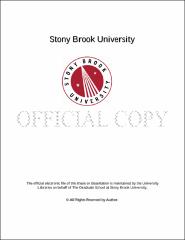| dc.identifier.uri | http://hdl.handle.net/11401/77834 | |
| dc.description.sponsorship | This work is sponsored by the Stony Brook University Graduate School in compliance with the requirements for completion of degree. | en_US |
| dc.format | Monograph | |
| dc.format.medium | Electronic Resource | en_US |
| dc.language.iso | en_US | |
| dc.publisher | The Graduate School, Stony Brook University: Stony Brook, NY. | |
| dc.type | Dissertation | |
| dcterms.abstract | Ancient water management, especially for irrigation purposes, has featured prominently in anthropological theories on the development of socio-political and economic complexity. Traditional approaches have assumed that centralized control was needed to meet the managerial requirements of water control on a large scale. However, recent ethnographic and archaeological studies have shown that centralized control is a choice rather than a necessity. To date, there has been no empirical study on the exact nature of state control (if any) in the organization of ancient water control and irrigation. This is problematic as understanding the role of the state is at the center of how the function of water control (whether for irrigation and other purposes) in early complex societies is conceptualized. This shortcoming is primarily due to the lack of empirical data on the management of ancient water control systems and relatively few data on their physical attributes (layout, size and technical complexity) for most of the relevant ancient cases (Nile Valley [Egypt], Indus Valley [Pakistan/India], Yangtze and Yellow Rivers in China). The only exception is ancient Mesopotamia with its extraordinarily rich archaeological and historical record on ancient water control. This thesis presents an analysis of the oldest and most comprehensive record on ancient water control from the archive of the Umma province of the Ur III state (2112–2004 B.C.). This rich data set has allowed, the development of a detailed insight into the technological and social aspects of ancient water control, which allows us to address larger theoretical questions regarding the role of the state in ancient water management and its importance for the functioning of an early state society. This research is based on the analysis of cuneiform administrative documents, complimented by archaeological and comparative ethnographic/ethno-historical data. The results show that water courses in the Umma province were managed not only for irrigation but also for navigation and flood control. While irrigation was crucial for the production of agricultural surplus, it was waterborne transportation that allowed for its efficient distribution throughout the state and its urban centers. Moreover, given that peak flooding of the Euphrates and Tigris coincides with the harvest, flood control was as important as irrigation. Thus, a major component of the water course management system of Umma was the effective control of the fluctuating water levels of the ancient Tigris in order to coordinate irrigation activities together with the requirements for navigation and flood control. The textual data also allowed a detailed description of the social aspects of the water management system, including labor organization, social inequality, gender relations, bureaucracy, and political centralization. Records of the names of officials in charge of supervising and authorizing the various work projects made it possible to reconstruct the chain of command and develop a precise description of the degree of centralized control of the watercourse management system. The management of the watercourses for navigation, irrigation and flood control was highly centralized at the provincial level under the authority of the governor (ensi2). The system was organized by a staff of full- and part-time state administrators and workers who planned and scheduled the timely execution of the required work projects all the way down to the field level. Planning and scheduling work projects was based on a complex accounting system and computational procedures that allowed for assessing the workload, converting it into the labor and the material costs on which basis labor was mobilized and materials gathered. The role of the central government, on the other hand, was restricted to the occasional resolution of water disputes between towns and cities. Beyond that there is no indication of any interference of the central government in the management of watercourses at the local level, providing important insights into how state control was realized on the local level in an ancient state society. | |
| dcterms.available | 2017-09-26T17:23:06Z | |
| dcterms.contributor | Zimanksky, Paul | en_US |
| dcterms.contributor | Stone, Elizabeth C. | en_US |
| dcterms.contributor | Hildebrand, Elisabeth | en_US |
| dcterms.contributor | Hunt, Robert | en_US |
| dcterms.contributor | Steinkeller, Piotr. | en_US |
| dcterms.creator | Rost, Stephanie | |
| dcterms.dateAccepted | 2017-09-26T17:23:06Z | |
| dcterms.dateSubmitted | 2017-09-26T17:23:06Z | |
| dcterms.description | Department of Anthropology. | en_US |
| dcterms.extent | 308 pg. | en_US |
| dcterms.format | Application/PDF | en_US |
| dcterms.format | Monograph | |
| dcterms.identifier | http://hdl.handle.net/11401/77834 | |
| dcterms.identifier | Rost_grad.sunysb_0771E_12289.pdf | en_US |
| dcterms.issued | 2015-05-01 | |
| dcterms.language | en_US | |
| dcterms.provenance | Submitted by Jason Torre (fjason.torre@stonybrook.edu) on 2017-09-26T17:23:06Z
No. of bitstreams: 1
Rost_grad.sunysb_0771E_12289.pdf: 4980935 bytes, checksum: 51ba706af738554bf6e36001cd15476e (MD5) | en |
| dcterms.provenance | Made available in DSpace on 2017-09-26T17:23:06Z (GMT). No. of bitstreams: 1
Rost_grad.sunysb_0771E_12289.pdf: 4980935 bytes, checksum: 51ba706af738554bf6e36001cd15476e (MD5)
Previous issue date: 2015-01-01 | en |
| dcterms.publisher | The Graduate School, Stony Brook University: Stony Brook, NY. | |
| dcterms.subject | Archaeology | |
| dcterms.subject | Ancient Administration, Ancient Political Ecology, Ancient Water Management, Cuneiform Writing, Early States, Mesopotamia | |
| dcterms.title | Watercourse Management and Political Centralization in Third-Millennium B.C. Southern Mesopotamia: A Case Study of the Umma Province of the Ur III Period (2112–2004 B.C.). | |
| dcterms.type | Dissertation | |


